We decided to travel around Little Ireland (the Eyre Peninsula) rather than cut straight across to the Nullarbor route for one reason – shark diving. We wanted to get into a cage submerged in the cold cold water of the Neptune Islands and scare ourselves sideways as Great White Sharks got up in our faces. Port Lincoln is the only place in Australia that you can do this.
We noted on the website of the shark diving company that they were certified by the ecotourism board and CSIRO, but we didn’t study the environmental politics of the activity before we arrived. By the time we got to Port Lincoln, all three shark diving companies were on hiatus for the next four days. Apparently, there is now a government mandate for a four day break within every fortnight, in order to convince the sharks to go about their normal sharky lives rather than hang around to be fed. We didn’t have the time to wait that long – especially as there wasn’t anything else to do in Port Lincoln unless you really like tuna trawlers, so we carried on to Coffin Bay feeling disappointed, but also a tad relieved.
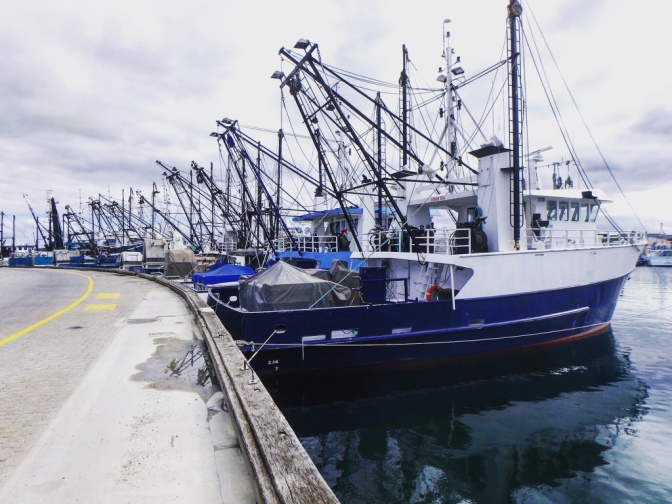
We’d heard of Coffin Bay oysters or at least seen them on a menu before – usually arriving artfully placed on a bit of driftwood, but neither of us could recall eating them. When we arrived in Coffin Bay, another picturesque afterthought of a town, we asked the lady in the general store to shuck us a few, as every business seemed to offer them for sale, from the restaurants to the hairdressers. She had just run out, so she sent us up the road to the oyster sheds.
It was here we met Simon, an oyster farmer who was unloading and sorting his harvest for the day. He gave us a lesson in oysters, explaining how they get from the sea to your local art wank restaurant. Every day Simon wakes up about 5am (depending on the tides) and takes his boat out to the oyster beds. He gets into the cold dark water and pulls all of the cages into his boat, while also putting yesterday’s dud oysters back into the bed to keep growing (like throwing back an undersized fish).
Arriving back at the oyster shed a few hours later, he single-handedly opens all the cages and sorts every oyster, working out which is too small, which is too dead and which is just right. These go into big hessian bags which are picked up by truck drivers and delivered all over Australia, as well as travelling to high-flying restaurants in Shangai, Singapore and Hong Kong.
On a non-harvest day he still has to do other oyster business – moving the baby oysters known as ‘spats’ to bigger oyster beds. We imagine he lures them across by singing an enchanting song and dancing about jovially like the fat walrus in Alice in Wonderland. Each oyster at this stage is four to six millimetres long and a million seeds only weigh 20kg but will increase to weigh 100 tonnes in a good year. Whoa.


After all of this exhausting work, Simon goes home to a delicious dinner of chicken nuggets, because he doesn’t like oysters very much.
Simon said backpackers often help him out. Of course this comment was followed by a retelling of all the backpacker murder stories he knows. He then tried to recruit us to help him on the boat the next day, but made the mistake of mentioning that he was attacked by a shark on his second day in the job.
Most fishermen and oyster farmers on the Eyre Peninsula think shark cage diving is a bad idea. The cage diving businesses are training Great Whites to associate humans with food, chumming the water with bloody muck to excite them while simultaneously lowering human meat bags into the water. This is bad for the sharks because, as evidenced by the four day break the government has initiated, they now expect the boats to feed them. It’s also bad for fishermen and surfers, because it encourages sharks to attack them.
It’s a case of life imitating art – we’re creating Jaws, sharks driven by a blood lust for humans. And this nasty cycle results in shark attacks and shark culling – punishing the sharks for what we have unwittingly trained them to do. These cage diving companies claim that they’re conducting research which will ultimately benefit the species, and this may be true, but can it be legit research if you’re influencing the behaviour? Isn’t it better to support organisations like OCEARCH, where you can track your favourite shark on your phone as it travels around the world, and get your adrenalin kicks somewhere else.
RANT OVER.
We left the oyster sheds with a dozen Coffin Bay oysters and a lot of new information for our heads to process. We drove into Coffin Bay National Park to check out some dunes and coast views, and were rewarded with a glimpse of a family of emus who ran across the road, each emu in the train smaller than the last, with the stripey babies scuttling through the legs of the elders.
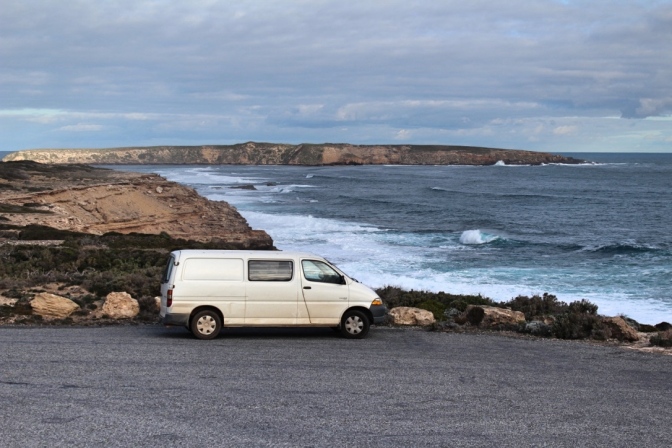

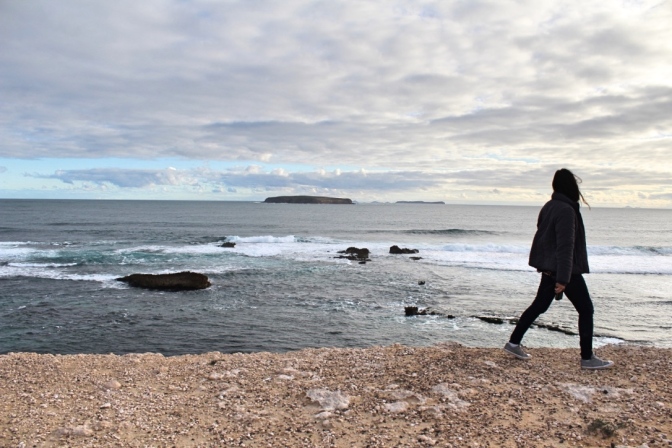

Coles Point was the designated campsite for the evening. The camping area was on a sheer cliff face and Shelley baulked at the idea of parking on such a narrow precipice in high winds, even though it’s what Instagram would have wanted. We backed off a bit, finding some shelter in the scrub and turned our attention to the oysters. Using the technique Simon showed us, we managed to prise them open with the Leatherman without slicing open the life lines of our left hands. Old mate had thrown in a few extra so we ended up with 16 oysters for $10.00! Feeling very VIP, we ate half au naturale with a splash of lemon, and cooked the rest in a pan on the gas stove, poaching them in their own juices before dousing them with a tangy mixture of lemon, white wine vinegar, hot sauce and Lee & Perrins. Washing it all down with one of those Godzilla-size Asahi cans, we had a marvellous time in our camping chairs on the cliff tops of the Southern Ocean, enjoying the oyster experience much more than if we were in a restaurant, eavesdropping on the pomposity of other tables as we feel around on the floor for that linen napkin that keeps sliding off our knees.
Gaz suggested that we go back and buy more Coffin Bay Oysters, but we knew it was time to push on to the Nullarbor Plain and the open expanse of boredom that awaited us.
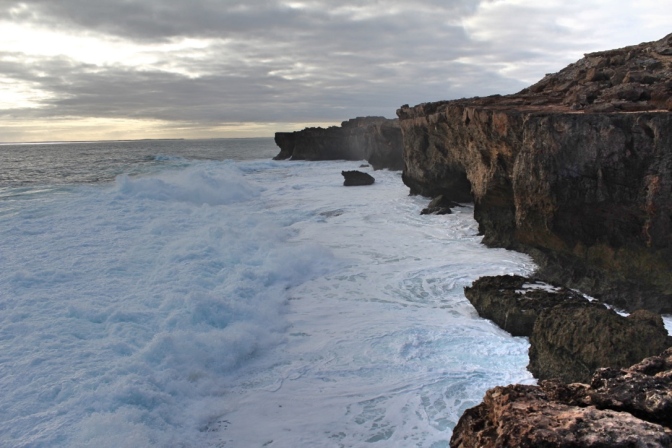

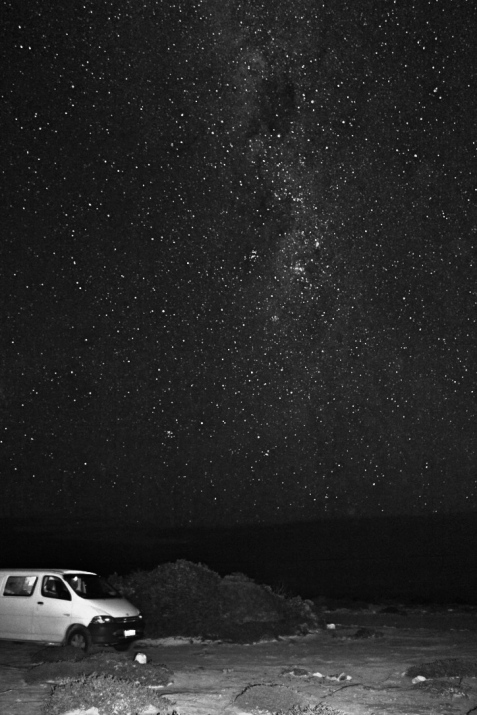


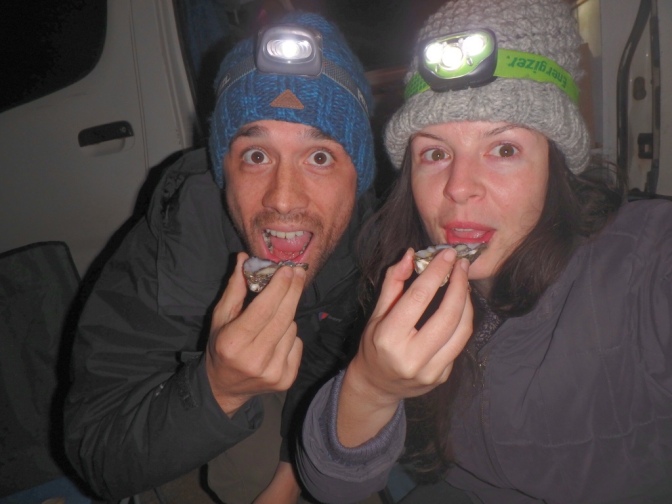
Great post! 🙂
LikeLiked by 1 person
Thanks very much Roselinde!
LikeLike
Love the authentic feel of this post! OMG the stars in this bottom right photo are amazing! I really like your writing style and will be checking out more!
LikeLiked by 1 person
Thanks! That Reuben sandwich in your last post makes me wish were roadtrippin the US instead of Oz!
LikeLiked by 1 person
coffin bay oysters……Shannon Bennet would drool! Try to lift the tone a bit in front of the pommie bloke!
LikeLiked by 1 person
hahaha you guys look funny with those lights on your heads!
LikeLiked by 1 person